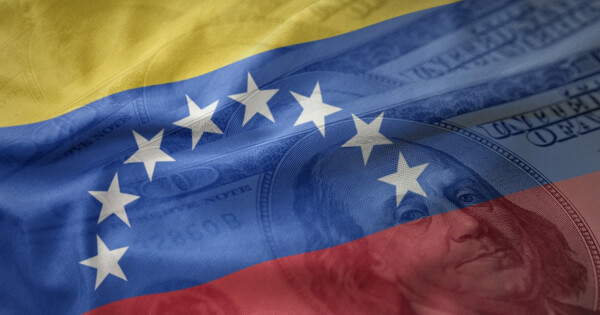3 Feb, 21
The US uses stablecoins for foreign aid – What’s next?

In November of 2020, it was reported that payments company Circle has been working with the United States government to develop a reliable method to provide foreign aid to Venezuela in a way that bypasses the Nicolás Maduro government and directly supports the country’s population. Their chosen method? Through stablecoins. In this article, we cover the American logistics of how the US uses stablecoins for foreign aid in Venezuela, other benefits that those currencies bring and what we can expect for the future of stablecoins in other applications beyond international policies.
What are stablecoins?
Stablecoins are digital currencies that have their value wrapped under a fiat currency or commodity. Primary examples seen in the market are stablecoins such as USDT and USDC, and gold-backed stablecoins such as Paxos Gold, backed by the gold held in Brink’s vaults. Such currencies are broadly used in crypto exchanges as the base-value for transactions and provide an onramp for crypto and altcoins. They play an essential role in the global market due to its low transaction fees, superior speed and open architecture to embed in payment applications.
The US x Venezuela foreign aid strategy
It is widely known that Venezuela has been facing one of the biggest financial crises in modern history. The economic meltdown left the country astray with the highest inflation levels in world’s history. The nation reached its peak yearly inflation in 2018, with 130,060%. From 2016 to 2019, the Central Bank of Venezuela admitted that hyperinflation reached the heights of 53 million per cent, using the state’s public food supplies as reference. It left the economy in shambles, with products like a hamburger costing more than the minimum monthly wage of US$3.61.
With a country in such immense distress, it would be logical for its leaders to accept humanitarian assistance from other nations. Nicolás Maduro, however, has been profusely rejecting any form of aid under the argument that the Venezuelan people “are not beggars”. Foreign aid policy is more than a necessity for the South American nation, but bypassing a disputed president’s government is an enormous challenge to overcome.
So why are stablecoins better for the task? The population uses mobile crypto wallets, which the government has no sovereignty to access. Although they can monitor transactions, it is quite challenging to identify the citizen behind their usage without a proper KYC procedure. Venezuelans are no strangers to digital currencies; the current crisis is booming crypto use for not only humanitarian aid from independent organisations, but as a hedge against the country’s frenetic inflation rates. Now the US is joining in the effort, using the benefits of digital assets to help people in dire situations as fast as possible, without bureaucratic or political obstacles.
So with the population already familiar with cryptocurrencies and millions possessing their own digital wallets, the United States is partnering with payments company Circle to send USDC, a USD-backed coin, directly to people’s digital addresses. The distributed relief funds will then be instantly available to trade and spend in American dollars, a far more stable currency than the national Bolivar, which inflated 1,858% in the last twelve months.
What are other uses for stablecoins?
Due to their fiat-backed nature allied with instantaneous transactions at low fee rates, stablecoins are also being adopted into the traditional banking system to minimise the transactional costs, which can reach a considerable percentage for international transfers or credit lines. For instance, JPMorgan Chase & Co currently uses their own stable currency, JPM Coin, to settle transactions for institutional clients for rapid exchange and low rates. Visa has also formed a partnership with issuers of USDC, to provide the stablecoin for their platform users.
Related to the novel way the US uses stablecoins for foreign aid, the assets are also introducing marginalised populations into modern banking. According to the Global Findex, 1.7 billion people worldwide live with no access to traditional banking. As we covered in our article on Crypto Integration in Africa, a substantial portion of the population does not have access to conventional banking and are having their first contact with digital finances directly through mobile services. Stablecoins and other digital assets fill the gap for economic inclusion and market reachability in developing regions, boosting the economy of otherwise hard-to-reach territories.
The last couple of years have also seen the rapid development of Central Bank Digital Currencies, which are coins issued, regulated and backed through a fiat currency of a single nation or territory. China’s Digital Yuan is in its final stages of trials, Sweden is developing and testing the coin E-krona, and other governments have shown their interest in studying the benefits of CBDCs, such as the United States, the European Union, Australia and Brazil. Central Bank Digital Currencies can help develop a more efficient financial system and reduce transaction fees and exchange delays, although they will still be centralised and fully regulated by a particular government.
What lies ahead
Considering the current developments and usage of stablecoins, it is safe to argue that such a category of digital currencies is gradually making its way into daily lives, and that includes foreign aid as the only official application so far of how the US uses stablecoins. Whether as a replacement or supplement for fiat currencies, other applications for the assets are nearly endless; e-commerce through global bank settlements, peer-to-peer transactions, decentralised entertainment, online betting, e-sports industry, the list goes on. As stablecoins become more common in society, so will the use of cryptocurrencies which offer a much larger spectrum of utilities under a decentralised network.
There will still be many challenges ahead, such as the governmental control over digital currencies in a population that might eventually rely solely on cashless methods for their finances. But where there are obstacles, there’s also plenty of opportunities for those currencies to make life easier and more efficient for all, with the prospect of a borderless and nearly-instant financial system that covers most nations and facilitates financial support for those who need it the most.
Zerocap provides digital asset investment and custodial services to forward-thinking investors and institutions globally. Our investment team and Wealth Platform offer frictionless access to digital assets with industry-leading security. To learn more, contact the team at [email protected]
Like this article? Share
Latest Insights
Ethereum Smart Contracts: How They Changed Crypto
Ethereum, launched in 2015, revolutionized the digital world by introducing “smart contracts,” self-executing contracts with the terms of the agreement directly written into code. This
Main Crypto Events in the World
The world of cryptocurrencies is dynamic and ever-evolving, with numerous conferences and events held globally to foster innovation, collaboration, and networking among crypto enthusiasts. Here’s
What is Ethena Finance?
Ethena Finance (ENA/USDe) is emerging as a notable player in the cryptocurrency and decentralized finance (DeFi) sectors. Powered by its proprietary stablecoin, USDe, Ethena aims
Receive Our Insights
Subscribe to receive our publications in newsletter format — the best way to stay informed about crypto asset market trends and topics.



 Share
Share  Tweet
Tweet  Post
Post 